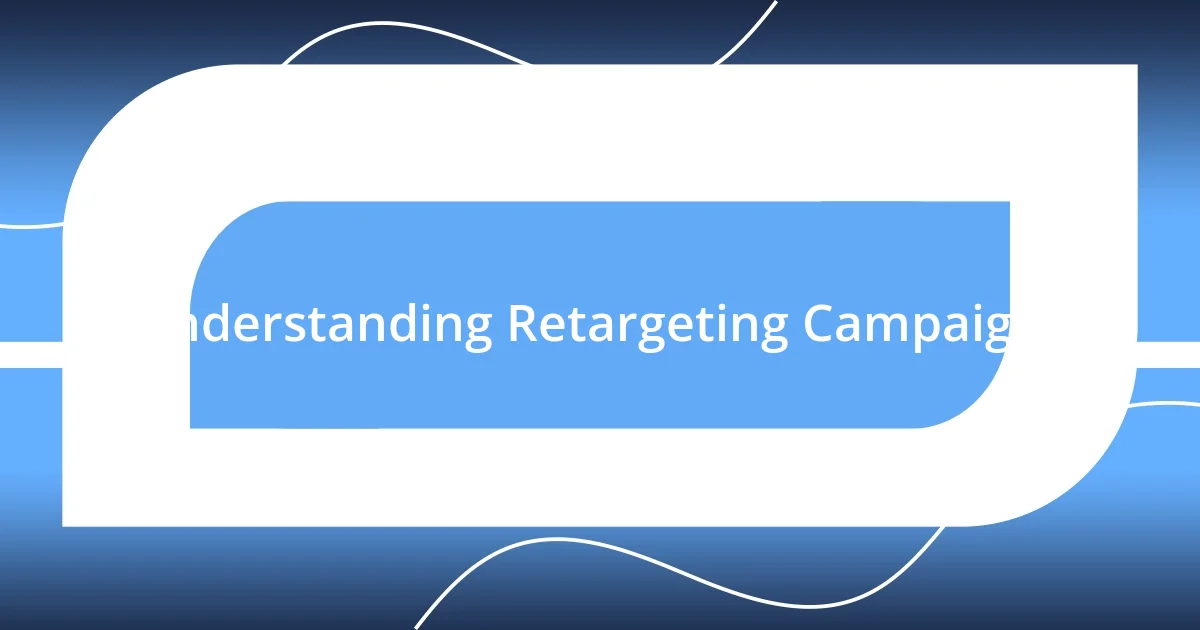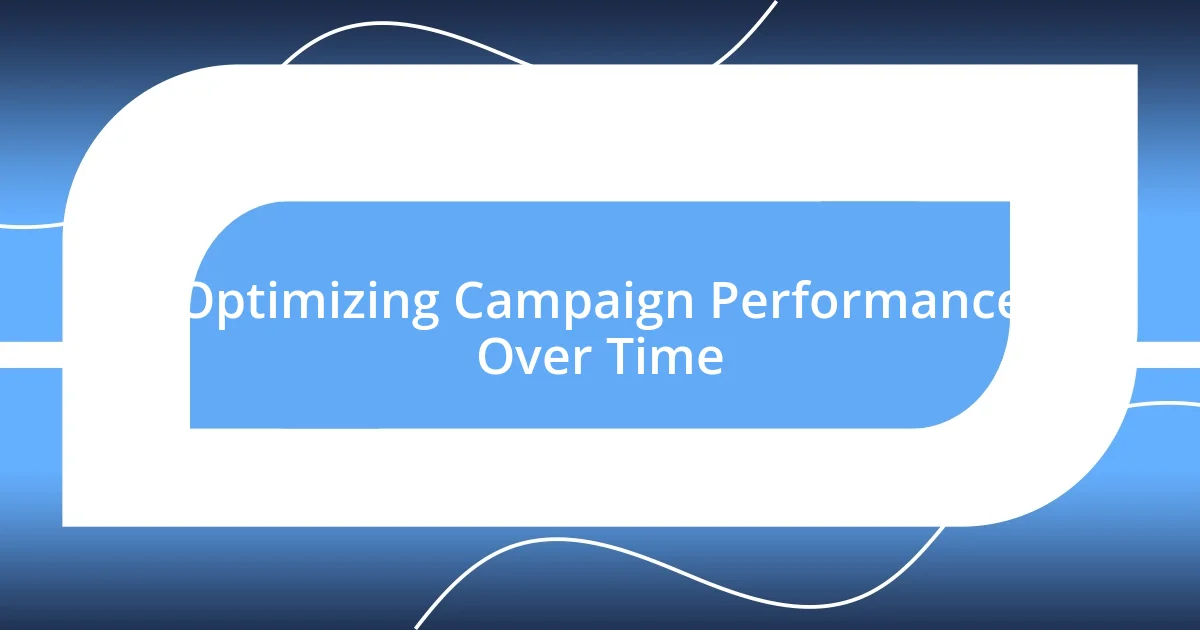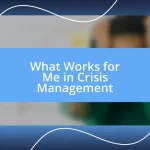Key takeaways:
- Retargeting campaigns successfully re-engage potential customers by reminding them of their previous interests, increasing brand visibility and conversion rates.
- Effective setup involves audience analysis, segmentation, and frequency management to create personalized messages without overwhelming users.
- Continuous optimization through performance analysis, creative refreshes, and adaptability to trends enhances the effectiveness and relevance of retargeting campaigns over time.

Understanding Retargeting Campaigns
Retargeting campaigns focus on re-engaging users who have previously interacted with your brand. I remember the first time I stumbled upon an ad for a pair of shoes I had browsed earlier; it felt almost serendipitous. That moment made me realize how powerful it is to connect with potential customers right when they are still thinking about your product.
By reminding users of their previous interests, retargeting not only boosts brand visibility but also increases the chances of conversion. I often find myself wondering how many sales are lost simply because a customer forgot what caught their eye. This strategy acts like a friendly nudge, gently steering users back toward their initial curiosity.
Incorporating various channels—like social media and email—can enhance the effectiveness of your retargeting efforts. I once received a carefully timed email featuring products I had looked at online, and it reignited my interest. Isn’t it fascinating how a well-placed reminder can transform fleeting interest into a solid purchasing decision?

Setting Up Effective Retargeting
Setting up effective retargeting requires a keen understanding of your audience’s journey. I recall a time when I first ventured into creating a retargeting campaign for a local café. I analyzed my website traffic and identified users who checked out the menu but didn’t make a reservation. The key was crafting personalized ads that resonated with their previous actions, inviting them back with enticing visuals of our signature dishes.
Utilizing segmentation is another powerful strategy that I have found invaluable. By categorizing users based on specific behaviors—like those who abandoned their shopping cart versus those who just browsed—I could tailor my approach. It felt like speaking directly to the person’s experience, which made the messages more relevant. The difference in engagement was staggering; targeted ads truly outperformed generic ones, creating a more personal connection.
Lastly, frequency is something I emphasized while implementing these campaigns. Too often, I’ve noticed brands bombard users with ads, which can feel invasive. I aimed for a balanced frequency that kept our café fresh in their minds without overwhelming them. Striking that right chord often meant understanding when to pause advertising to keep interest alive. What a difference it makes when you treat every viewer like a valued guest rather than just another statistic!
| Element | Importance |
|---|---|
| Audience Analysis | Understanding user behavior helps tailor messaging |
| Segmentation | Allows for personalized ad experiences |
| Frequency Management | Prevents viewer fatigue while maintaining engagement |

Choosing the Right Audience Segments
Choosing the right audience segments for retargeting campaigns can greatly influence their success. I remember when I launched a campaign targeting users who visited a specific product page but didn’t convert. It was like casting a net to catch those who were already intrigued. I found that focusing on those who had shown sustained interest rather than a broader audience led to much higher click-through rates. That moment of clarity made me realize the essence of segmentation—it’s about reconnecting with people who already have a connection with your brand.
Here’s what I found useful when selecting audience segments:
- Past Purchasers: Target previous customers for upselling or cross-selling opportunities.
- Cart Abandoners: Focus on users who left items in their carts, directly reminding them to complete their purchase.
- Engaged Visitors: Retarget users who spent significant time browsing specific content, showcasing related products or offers.
- Event Attendees: Reach out to people who participated in previous events, creating a personalized follow-up.
- Product Reviewers: Engage users who left feedback, encouraging them to explore more of your offerings.
By narrowing down the focus this way, I was able to create more tailored messages that resonated on a deeper level. It turned a simple reminder into a meaningful outreach, transforming curiosity into commitment.

Crafting Engaging Ad Creatives
Creating engaging ad creatives can truly transform the effectiveness of retargeting efforts. I fondly recall the time I decided to incorporate a storytelling approach into my ads for a fitness app. Instead of just showcasing features, I shared user success stories, complete with before-and-after images. This shift not only sparked emotional connections but also inspired potential users to envision themselves achieving similar results. Have you ever noticed how compelling narratives can draw you in and make you feel part of something bigger?
In my journey with ad creatives, I learned the value of visual elements. Bright, appealing images can stop someone in their scrolling tracks, but they must align with the message. For example, using vibrant colors that evoke energy and friendliness proved successful when marketing a healthy snack brand. I remember the rush I felt when I saw engagement doubles after adjusting the visuals. It’s like finding the right mood music for a gathering—everything just clicks!
Finally, the call-to-action (CTA) is where the magic happens. I once crafted a campaign with a simple “Join us today!” CTA, and it sparked a significant uptick in sign-ups for a community event. The excitement of inviting people rather than just informing them felt like an open door rather than a closed one. Have you ever considered how a friendly invitation might increase your conversion rates? It’s all about making your audience feel welcomed and inspired to take that next step.

Measuring Retargeting Campaign Success
Measuring the success of retargeting campaigns requires a clear set of metrics to truly understand their impact. For instance, I often start by monitoring click-through rates (CTR) and conversion rates. During a campaign aimed at users who viewed a sale but didn’t purchase, I discovered that even a slight improvement in CTR could significantly boost our return on investment. It’s like following the breadcrumbs; each click tells a story about user interest and engagement.
Another critical aspect is tracking the customer’s journey beyond the initial click. When I analyzed the lifetime value (LTV) of customers acquired through retargeting, I was surprised to see how much more they spent compared to first-time visitors. It made me realize that these campaigns not only capture immediate sales but also build long-lasting relationships with our audience. Have you ever thought about how one successful interaction could set the stage for future loyalty?
I also can’t stress enough the importance of A/B testing in measuring success. I recall experimenting with different ad copies, and the results were eye-opening. One version featured an exclusive offer, and it outperformed the generic one by a mile. It taught me that even minor adjustments could lead to striking differences in engagement. Isn’t it fascinating how small changes can lead to such significant outcomes? Understanding these nuances has transformed how I approach my marketing strategies.

Optimizing Campaign Performance Over Time
Optimizing retargeting campaigns over time is essential for sustained success. From my personal experience, I found that regularly analyzing performance data gave me valuable insights. For example, I once noticed that certain demographics responded better to specific offers. Adjusting my approach to speak directly to these audiences not only improved engagement but also created a deeper connection. Have you ever thought about how understanding your audience can reshape your strategy?
I also learned the importance of continuous creative refreshes. One time, I allowed an ad to run for too long without changes, and the performance began to dwindle. When I introduced fresh visuals and updated messaging, it was like breathing new life into the campaign. The spike in engagement was exhilarating, akin to reinvigorating a conversation with an old friend. Have you ever been surprised how new perspectives can revive interest?
Lastly, I can’t emphasize enough how vital it is to stay adaptable. As trends shift, so should your campaigns. I always keep a finger on the pulse of market changes, adjusting my retargeting strategies accordingly. When I pivoted my ads to align with a social media trend, the results were astounding. It’s a bit like riding a wave; timing is everything! How do you stay current and responsive in your own marketing efforts? Providing a dynamic approach ensures your campaigns remain relevant and impactful.














